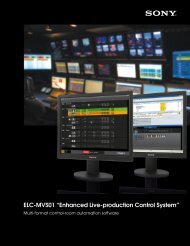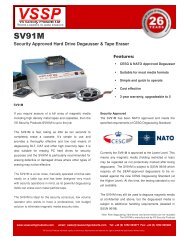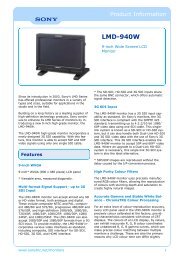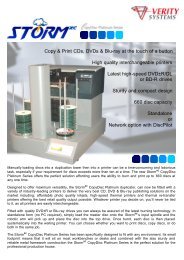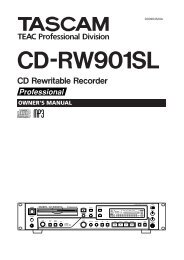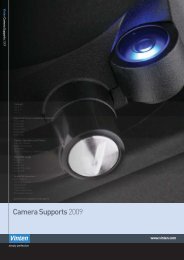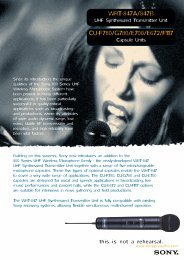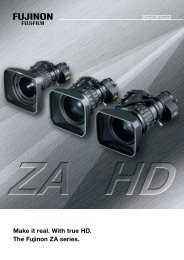DIGITAL PRODUCTION IN THE NETWORKED AV/IT ERA MPEG ...
DIGITAL PRODUCTION IN THE NETWORKED AV/IT ERA MPEG ...
DIGITAL PRODUCTION IN THE NETWORKED AV/IT ERA MPEG ...
Create successful ePaper yourself
Turn your PDF publications into a flip-book with our unique Google optimized e-Paper software.
<strong>MPEG</strong> IMX FAMILY<strong>THE</strong> <strong>MPEG</strong> IMX SYSTEMTECHNOLOGY BUILT ON OPEN STANDARDS<strong>MPEG</strong> IMX incorporates the latest advances inproduction technology and is designed to fullymeet recognised industry standards. Technologiesare only incorporated where they providedemonstrable new benefits to the end user. Someof the latest technologies to be incorporated intothe <strong>MPEG</strong> IMX system are explained here.Broadcast Quality Pictures with D-10 OperationThe Society of Motion Picture and Television Engineers(SMPTE) has issued two standards on which <strong>MPEG</strong>IMX is based. These standards, known as D-10, wereissued to ensure seamless operation between productsfrom multiple manufacturers, including inter-operabilitywith the Sony XPRI non-linear editing system and withthe Sony Professional Disc system.The first D-10 standard, SMPTE 356M, describes an<strong>MPEG</strong>-2 4:2:2P@ML data stream employing Intraframe(I-frame) compressed video encoding. SMPTE356M provides for recording at 50 Mb/s for the highestquality Standard Definition video performance andmulti-generation editing.The second SMPTE D-10 standard is SMPTE 365M.This describes all aspects of the physical recordingwithin a tape-based recorder. It contains details of therecorded data tracks on tape and the dimensions of thecassette. <strong>MPEG</strong> IMX camcorders, studio recorders andplayers conform to the two D-10 standards.Eight Channels of Digital AudioSelected devices within the <strong>MPEG</strong> IMX product line-upcan record and playback eight channels of 48kHzdigital audio at 16-bit resolution. <strong>MPEG</strong> IMX studiorecorders and players can also be switched to fourchannel operation at 24-bit 48kHz via a user selectableset-up menu.Longest-Ever Recording Times<strong>MPEG</strong> IMX provides the longest-ever long recordingtime on a 1 ⁄2-inch Betacam-family cassette. A maximumof 220 minutes can be stored on a large cassette and 71minutes on a small cassette when recording in 625/50mode.Lossless Transfer of <strong>MPEG</strong>-2 DataThe Serial Data Transport Interface – Content Package(SDTI-CP) is another SMPTE standard employed within<strong>MPEG</strong> IMX. SDTI-CP is an interface that transportsthe D-10 <strong>MPEG</strong> IMX data from one device to another.It transfers the data in its native D-10 form, guaranteeing aperfect data copy from one D-10 device to the next. <strong>MPEG</strong>IMX studio recorders use SDTI-CP to transfer video andaudio from <strong>MPEG</strong> IMX cassettes at up to twice normalspeed to D-10-compliant disk recorders and servers.Compatibility with Betacam, Betacam SP,Betacam SX and Digital Betacam<strong>MPEG</strong> IMX maintains compatibility with currentanalogue and digital systems. This compatibilityprovides a logical, cost-effective migration path to acombined <strong>AV</strong>/<strong>IT</strong> operation.Metadata EnabledRapid access to content is critical when producing,repurposing and distributing content across multipleplatforms. SMPTE has standardised the Unique MaterialIdentifier (UMID) to radically improve the searching forand access to material. The UMID provides a uniquelabel for each item of video and audio and canbe tracked throughout the production chain. The UMIDcan link video and audio material on tape or disk toproduction notes, scripts and viewer information heldwithin an external database. This fully integrates allaspects of content production.File-Based Operation using MXFThere is a continuing shift from traditional step-by-stepprogramme production to workgroup-based productionacross computer networks. The increased speed ofnetworks and the availability of lower cost <strong>IT</strong> componentscontinue to accelerate the rate of this change.But workgroup operation can only succeed when standardisedformats exist for the file-based exchange ofvideo and audio material. The Professional <strong>MPEG</strong>Forum recognised this need, and worked to create MXF(the Material Exchange Format).MXF is a file exchange mechanism for the movementof video, audio and metadata across a network. MXFhas been developed for storage on a variety of media,and operates independently of any specific network oroperating system. MXF is compression independentand can carry many different content types as its payload,including <strong>MPEG</strong> IMX, HDCAM, DVCAM, DVCPROand uncompressed video.MXF has been designed to be fully expandable forfuture applications, and provides an extremely comprehensivemetadata capability. MXF is an open, widelysupported and clearly documented file format that isused in products such as the <strong>MPEG</strong> IMX-based e-VTRwhere traditional stream-based <strong>AV</strong> production canco-exist within file-based operations.Fully Networkable for Combined <strong>AV</strong>/<strong>IT</strong> OperationMXF can transfer <strong>MPEG</strong> IMX video, audio and metadatabetween devices as computer files. Gigabit Ethernetinterfaces are being added to products within the<strong>MPEG</strong> IMX line-up to facilitate efficient exchange ofthese files. In addition to a number of <strong>MPEG</strong> IMX diskbaseddevices, a Gigabit Ethernet interface can now beadded to an <strong>MPEG</strong> IMX VTR to provide e-VTR operationusing TCP/IP and File Transfer Protocol (FTP).4



